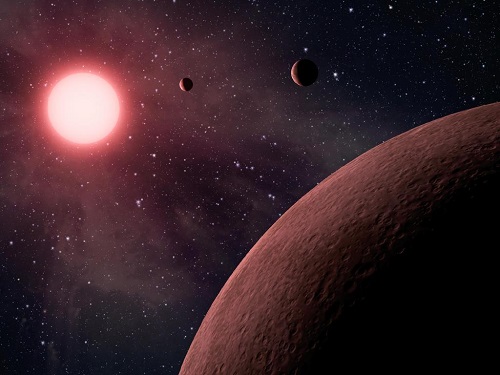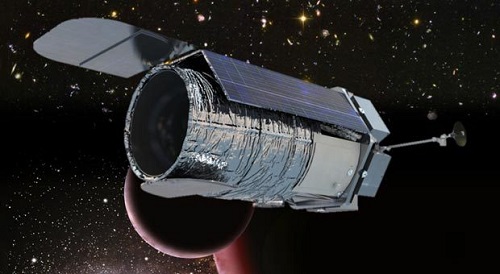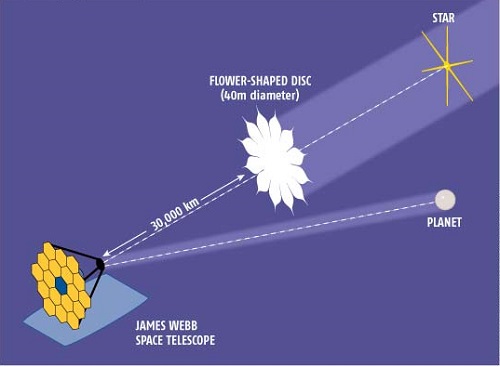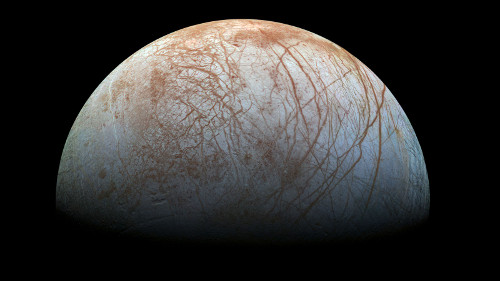Centauri Dreams
Imagining and Planning Interstellar Exploration
Atmospheric Turmoil on the Early Earth
Yesterday’s post about planets in red dwarf systems examined the idea that the slow formation rate of these small stars would have a huge impact on planets that are today in their habitable zone. We can come up with mechanisms that might keep a tidally locked planet habitable, but what do we do about the severe effects of water loss and runaway greenhouse events? Keeping such factors in mind plays into how we choose targets — very carefully — for future space telescope missions that will look for exoplanets and study their atmospheres.
But the question of atmospheres on early worlds extends far beyond what happens on M-dwarf planets. At MIT, Hilke Schlichting has been working on what happened to our own Earth’s atmosphere, which was evidently obliterated at least twice since the planet’s formation four billion years ago. In an attempt to find out how such events could occur, Schlichting and colleagues at Caltech and Hebrew University have been modeling the effects of impactors that would have struck the Earth in the same era that the Moon was formed, concluding that it was the effect of small planetesimals rather than any giant impactor that would have destroyed the early atmosphere.
“For sure, we did have all these smaller impactors back then,” Schlichting says. “One small impact cannot get rid of most of the atmosphere, but collectively, they’re much more efficient than giant impacts, and could easily eject all the Earth’s atmosphere.”

Image: An early Earth under bombardment. Credit: NASA.
A single large impact could indeed have dispersed most of the atmosphere, but as the new paper in Icarus shows, impactors of 25 kilometers or less would have had the same effect with a great deal less mass. While a single such impactor would eject atmospheric gas on a line perpendicular to the impactor’s trajectory, its effect would be small. Completely ejecting the atmosphere would call for tens of thousands of small impacts, a description that fits the era 4.5 billion years ago. Calculating atmospheric loss over the range of impactor sizes, the team found that the most efficient impactors are small planetesimals of about 2 kilometers in radius.
Schlichting believes that giant impacts cannot explain the loss of atmosphere, for recent work uses the existence of noble gases like helium-3 inside today’s Earth to argue against the formation of a magma ocean, the consequence of any such giant impact. From the paper:
Recent work suggests that the Earth went through at least two separate periods during which its atmosphere was lost and that later giant impacts did not generate a global magma ocean (Tucker & Mukhopadhyay 2014). Such a scenario is challenging to explain if atmospheric mass loss was a byproduct of giant impacts, because a combination of large impactor masses and large impact velocities is needed to achieve complete atmospheric loss… Furthermore, giant impacts that could accomplish complete atmospheric loss, almost certainly will generate a global magma ocean. Since atmospheric mass loss due to small planetesimal impacts will proceed without generating a global magma ocean they offer a solution to this conundrum.
The same impactors that drove atmospheric loss would, in this scenario, introduce new volatiles as planetesimals melted after impact. By the researchers’ calculations, a significant part of the atmosphere may have been replenished by these tens of thousands of small impactors. What happens to a newly formed planet that can lead to the emergence of life? Learning about the primordial atmosphere shows us a planet at a stage when life was about to take hold, which is why Schlichting’s team wants to move forward with an analysis of the geophysical processes that, in conjunction with small impactors, so shaped Earth’s early environment.
The paper is Schlichting et al., “Atmospheric Mass Loss During Planet Formation: The
Importance of Planetesimal Impacts,” Icarus Vol. 247 (February 2015), pp. 81-94 (abstract / preprint).

Enter the ‘Mirage Earth’
A common trope from Hollywood’s earlier decades was the team of explorers, or perhaps soldiers, lost in the desert and running out of water. On the horizon appears an oasis surrounded by verdant green, but it turns out to be a mirage. At the University of Washington, graduate student Rodrigo Luger and co-author Rory Barnes have deployed the word ‘mirage’ to describe planets that, from afar, look promisingly like a home for our kind of life. But the reality is that while oxygen may be present in their atmospheres, they’re actually dry worlds that have undergone a runaway greenhouse state.
This is a startling addition to our thinking about planets around red dwarf stars, where the concerns have largely revolved around tidal lock — one side of the planet always facing the star — and flare activity. Now we have to worry about another issue, for Luger and Barnes argue in a paper soon to be published in Astrobiology that planets that form in the habitable zone of such stars, close in to the star, may experience extremely high surface temperatures early on, causing their oceans to boil and their atmospheres to become steam.

Image: Illustration of a low-mass, M dwarf star, seen from an orbiting rocky planet. Credit: NASA/JPL.
The problem is that M dwarfs can take up to a billion years to settle firmly onto the main sequence — because of their lower mass and lower gravity, they take hundreds of millions of years longer than larger stars to complete their collapse. During this period, a time when planets may have formed within the first 10 to 100 million years, the parent star would be hot and bright enough to heat the upper planetary atmosphere to thousands of degrees. Ultraviolet radiation can split water into hydrogen and oxygen atoms, with the hydrogen escaping into space.
Left behind is a dense oxygen envelope as much as ten times denser than the atmosphere of Venus. The paper cites recent work by Keiko Hamano (University of Tokyo) and colleagues that makes the case for two entirely different classes of terrestrial planets. Type I worlds are those that undergo only a short-lived greenhouse effect during their formation period. Type II, on the other hand, comprises those worlds that form inside a critical distance from the star. These can stay in a runaway greenhouse state for as long as 100 million years, and unlike Type I, which retains most of its water, Type II produces a desiccated surface inimical to life.
Rodrigo and Barnes, extending Hamano’s work and drawing on Barnes’ previous studies of early greenhouse effects on planets orbiting white and brown dwarfs as well as exomoons, consider this loss of water and build-up of atmospheric oxygen a major factor in assessing possible habitability. From the paper:
During a runaway greenhouse, photolysis of water vapor in the stratosphere followed by the hydrodynamic escape of the upper atmosphere can lead to the rapid loss of a planet’s surface water. Because hydrogen escapes preferentially over oxygen, large quantities of O2 also build up. We have shown that planets currently in the HZs of M dwarfs may have lost up to several tens of terrestrial oceans (TO) of water during the early runaway phase, accumulating O2 at a constant rate that is set by diffusion: about 5 bars/Myr for Earth-mass planets and 25 bars/Myr for super-Earths. At the end of the runaway phase, this leads to the buildup of hundreds to thousands of bars of O2, which may or may not remain in the atmosphere.
Thus the danger in using oxygen as a biosignature: In cases like these, it will prove unreliable, and the planet uninhabitable despite elevated levels of oxygen. The key point is that the slow evolution of M dwarfs means that their habitable zones begin much further out than they will eventually become as the star continues to collapse into maturity. Planets that are currently in the habitable zone of these stars would have been well inside the HZ when they formed. An extended runaway greenhouse could play havoc with the planet’s chances of developing life.
Even on planets with highly efficient surface sinks for oxygen, the bone-dry conditions mean that the water needed to propel a carbonate-silicate cycle like the one that removes carbon dioxide from the Earth’s atmosphere would not be present, allowing the eventual build-up of a dense CO2 atmosphere, one that later bombardment by water-bearing comets or asteroids would be hard pressed to overcome. In both cases habitability is compromised.
So a planet now in the habitable zone of a red dwarf may have followed a completely different course of atmospheric evolution than the Earth. Such a world could retain enough oxygen to be detectable by future space missions, causing us to view oxygen as a biosignature with caution. Says Luger: “Because of the oxygen they build up, they could look a lot like Earth from afar — but if you look more closely you’ll find that they’re really a mirage; there’s just no water there.”
The paper is Luger and Barnes, “Extreme Water Loss and Abiotic O2 Buildup On Planets Throughout the Habitable Zones of M Dwarfs,” accepted at Astrobiology (preprint). The paper by Hamano et al. is “Emergence of two types of terrestrial planet on solidification of magma ocean,” Nature 497 (30 May 2013), pp. 607-610 (abstract). A University of Washington news release is also available.

Ground Detection of a Super-Earth Transit
Forty light years from Earth, the planet 55 Cancri e was detected about a decade ago using radial velocity methods, in which the motion of the host star to and from the Earth can be precisely measured to reveal the signature of the orbiting body. Now comes news that 55 Cancri e has been bagged in a transit from the ground, using the 2.5-meter Nordic Optical Telescope on the island of La Palma, Spain. That makes the distant world’s transit the shallowest we’ve yet detected from the Earth’s surface, which bodes well for future small planet detections.
Maybe ‘small’ isn’t quite the right word — 55 Cancri e is actually almost 26000 kilometers in diameter, a bit more than twice the diameter of the Earth — which turned out to be enough to dim the light of the parent star by 1/2000th for almost two hours. The planet’s period is 18 hours, bringing it close enough to reach temperatures on the dayside of 1700° Celsius. As the innermost of the five known worlds around 55 Cancri, 55 Cancri e is not a candidate for life.

Image: A comparison between the Earth and 55 Cancri e. Credit: Harvard-Smithsonian Center for Astrophysics.
Previous transits of this world were reported by two spacecraft, MOST (Microvariability & Oscillations of Stars) and the Spitzer Space Telescope, which works in the infrared. What’s exciting about the new transit observation is that as new observatories like TESS (Transiting Exoplanet Survey Satellite) come online, the number of small candidate worlds will zoom. Each will need follow-up observation, but the sheer numbers will overload both space-based and future ground observatories. Learning how to do this work using existing instruments gives us a way to put smaller telescopes into play, a cost-effective option for continuing the hunt.
The work on 55 Cancri e grows out of an effort to demonstrate the capacity of smaller telescopes and associated instruments for such detections. Having succeeded with one planet, the researchers look at some of the problems that arise when using moderate-sized telescopes:
In the case of bright stars, scintillation noise is the dominant limitation for small telescopes, but scintillation can be significantly reduced with some intelligent planning. With the current instrumentation, the main way to do this is to use longer exposure times and thereby reduce the overheads. However, longer exposure times will likely result in saturation of the detector, which can be mitigated by either defocusing the telescope (resulting in a lower spectral resolution, and possible slitlosses), using a higher resolution grating (which will decrease the wavelength coverage), or using a neutral density filter to reduce the stellar flux. The latter option will be offered soon at the William Herschel Telescope. Another possible solution is to increase default gain levels of standard CCDs.
So if we do find numerous super-Earths in upcoming survey missions, we can spread the task of planet confirmation to a broader pool of participants as our expertise develops. As for 55 Cancri itself, it continues to intrigue us, the first system known to have five planets. It’s also a binary system, consisting of a G-class star and a smaller red dwarf separated by about 1000 AU. While 55 Cancri e does transit, the other planets evidently do not, though there have been hints of an extended atmosphere on 55 Cancri b that may at least partially transit the star.
The paper is de Mooij et al., “Ground-Based Transit Observations of the Super-Earth 55 Cnc e,” accepted for publication in the Astrophysical Journal Letters (preprint).

WFIRST: The Starshade Option
What’s ahead for exoplanet telescopes in space? Ashley Baldwin, who tracks today’s exciting developments in telescope technology, today brings us a look at how a dark energy mission, WFIRST, may be adapted to perform exoplanet science of the highest order. One possibility is the use of a large starshade to remove excess starlight and reveal Earth-like planets many light years away. A plan is afoot to make starshades happen, as explained below. Dr. Baldwin is a consultant psychiatrist at the 5 Boroughs Partnership NHS Trust (Warrington, UK), a former lecturer at Liverpool and Manchester Universities and, needless to say, a serious amateur astronomer.
by Ashley Baldwin

Big things have small beginnings. Hopefully.
Many people will be aware of NASA’s proposed 2024 WFIRST mission. Centauri Dreams readers will also be aware that this mission was originally identified in the 2010 Decadal Survey roadmap as a mission with a $1.7 billion budget to explore and quantify “dark energy”. As an add-on, given that the mission involved prolonged viewing of large areas of space, an exoplanet “microlensing” element as a secondary goal, with no intrusion on the dark energy component, was also proposed.
Researchers believed that the scientific requirements would be best met by the use of a wide-field telescope, and various design proposals were put forward. All of these had to sit within a budget envelope that also included testing, 5 years of mission operations costs and a launch vehicle. This allowed a maximum aperture telescope of 1.5 m, a size that has been used many times before, thus reducing the risk and need to perform extensive and costly pre-mission testing, as had happened with JWST. As the budget fluctuated over the years, the aperture was reduced to 1.3 m.
Then suddenly in 2012 the National Reconnaissance Office (NRO) donated two 2.4 m telescopes to NASA. These were similar in size, design and quality to Hubble, so had lots of “heritage”, but critically they were also were wide-field, large, and worked largely but not exclusively in the infrared. What an opportunity: Such a scope would collect up to three times as much light as the 1.3 m telescope.
Tuning Up WFIRST
At this point a proposal was put forward to add in a coronagraph in order to increase the exoplanet and science return of WFIRST, always a big driver in prioritising missions. This coronagraph is a set of mirrors and masks, an “optical train” that is placed between the telescope aperture and the “focal plane” in order to remove starlight reaching the focal plane while allowing the much dimmer reflected light of any orbiting exoplanet to do so, allowing imaging and spectrographic analysis. Given the proposed savings presented by using a “free” mirror it was felt that this addition could be made at no extra cost to the mission itself.
The drawback is that the telescope architecture of the two NRO mirrors is not designed for this purpose. There are internal supporting struts or “spiders” that could get in the way of the complex apparatus of any type of coronagraph, impinging on its performance (this is what makes the spikes on images in reflecting telescopes). The task of fitting a coronagraph was not felt to be insurmountable, though, and the potential huge science return was deemed worth it so NASA funded an investigation into the best use of the new telescopes in terms of WFIRST.
The result was WFIRST-AFTA, ostensibly a new dark energy mission with all of its old requirements but with the addition of a coronagraph. Subsequent independent analyses by organisations such as the NRC (National Research Council – the auditors), however, suggested that the addition of a coronagraph could increase the overall mission cost to over $2 billion. This was largely driven by the use of “new” technology that might need protracted and costly testing. The spectre of JWST and its damaging costs still looms and now influences space telescope policy. Although the matter is disputed, it is based on the premise that despite over ten years of research, the technology is still thought to be somewhat immature and in need of more development. A research grant was gifted to coronagraph testbed centres to rectify this.

Image: An artist’s rendering of WFIRST-AFTA (Wide Field Infrared Survey Telescope – Astrophysics Focused Telescope Assets). From the cover of the WFIRST-AFTA Science Definition Team Final Report (2013-05-23). Credit: NASA / Goddard Space Flight Center WFIRST Project – Mark Melton, NASA/GSFC.
Another issue was whether the WFIRST budget will be delivered in the 2017 budget. This is far from certain, given the ongoing requirement to pay off the JWST “debt”. Those who remember the various TPF initiatives that followed a similar pathway and were ultimately scrapped at a late stage will shiver in apprehension. And that was before the huge overspend and delay of JWST, largely due to the use of numerous new technologies and their related testing. Congress was understandably wary of avoiding a repeat.
This spawned a proposal for the two cheaper “backup” concepts I have talked of before, EXO-S and EXO-C. These are probe-class concepts with a $1 billion budget cap. Primary and backup proposals will be submitted in 2015. EXO-S itself involved using a 1.1 m mirror with a 34 m starshade to block out light, rather than the coronagraphs of WFIRST-AFTA and EXO-C. Its back-up plan proposed using the starshade with a pre-existing telescope, which with JWST already having been irrevocably ruled out, left only WFIRST. Meanwhile, a research budget was allocated to bring coronagraph technology up to a higher “technology readiness level”.
Recently sources have suggested that the EXO-S back up option has come under closer scrutiny, with the possibility of combining WFIRST with a starshade becoming more realistic. At present that would only involve making WFIRST “starshade ready”, which involves the various two-way guidance systems necessary to link the telescope and a starshade to allow for their joint operation. The cost is only a few tens of millions and easily covered by some of the coronagraph research fund plus the assistance of the Japanese space agency JAXA (who may well fund the coronagraph too, taking the pressure off NASA). This doesn’t allow for the starshade itself however, which would need a separate, later funding source.
Rise of the Starshade
What is a starshade? The idea was originally put forward by astronomer Webster Cash from the University of Colorado in 2006; Cash is now part of the EXO-S team led by Professor Sara Seager from MIT. The starshade was proposed as a cheap alternative to the high-quality mirrors (up to twenty times smoother than Hubble) and advanced precision wavefront control of light entering the telescope. A starshade is essentially a large occulting device that acts as an independent satellite and is placed between any star being investigated for exoplanets and a telescope that is staring at them. In doing so, it blocks out the light of the star itself but allows any exoplanet light to pass (the name comes from the fact that starshades were pioneered to allow telescopic imaging of the solar corona). Exactly the same principle as a coronagraph only outside the telescope rather than inside it. The brightness of a planet is not determined by its star’s brightness so much as its own reflectivity and radius, which is why anyone viewing our solar system from a distance would see both Jupiter and Venus easier than Earth.

Image: A starshade blocks out light from the parent star, allowing the exoplanet under scrutiny to be revealed. Credit: University of Colorado/Northrup Grumman.
Any exoplanetary observatory has two critical parameters that determine its sensitivity. How close it can cut out starlight to the star, allowing nearby planets to be imaged, is the so-called Inner Working Angle, IWA. For the current WFIRST plus starshade mission, this is 100 milliarcseconds (mas), which for nearby stars would incorporate any planet orbiting at Earth’s distance from a sun. Remember that Earth sits within a “habitable zone”, HBZ, determined by a temperature that allows the presence of liquid water on the planetary surface. The HBZ is determined by star temperature and thus size, so 100 mas unfortunately would not allow viewing of planets much closer to a smaller star with a smaller HBZ, such as a K-class star. A slightly less important parameter is the Outer Working Angle, OWA, which determines how far out the imager can see from the star. This applies in the narrow field of coronagraphs but not to starshades, enabling planetary imaging for many astronomical units from the star.
The second key parameter is “contrast brightness” or fractional planetary brightness. Jupiter-sized planets are, on average, a billion times dimmer than their star in visible light, and this worsens by ten times for smaller Earth-sized planets. The difference drops by about 100-1000 times in infrared light. The WFIRST starshade is designed to work predominantly in visible light, just creeping into infrared at 825 nm. This is because the most common and cheap light detectors available for telescopes, CCDs, operate best in this range. Thus to image a planet, the light of a parent star needs reducing by at least a billion times to see gas giants and ten billion to see terrestrial planets. WFIRST reduces starlight by exactly ten billion times before its data is processed, with an increase to 3 to the power of minus 11 after processing. So WFIRST can view both terrestrial and gas giant planets in terms of its contrast imaging. The 100 mas IWA allows imaging of planets in the HBZ of Sunlike stars and brighter K-class stars (whose HBZ overlap with larger stars).
By way of comparison, WFIRST/AFTA can only reduce the star’s light by a billion times, which only allows gas giants to be viewed. Its IWA is just inside Mars’ orbit, so it can see the HBZ only for some Sun-like stars or larger, as light entering the telescope diminishes with distance. EXO-C can do better than this, and aims to view terrestrial planets for nearby stars. It is limited instead by the amount of light it can collect with its smaller 1.5 m aperture, less than half WFIRST and less still when passed through the extended “optical train” of the coronagraph and the deformable mirrors used in the critical precision wavefront control.
One thing that affects starshades and indeed all forms of exoplanet imaging is that other objects appearing in an imaging field can mimic a planet although they are in fact either nearer or further away. Nebulae, supernovae and quasars are a few of the many possibilities. In general, these can be separated out by spectroscopy, as they will have spectra different from exoplanets that mimic their parent star’s light in reflection. One significant exception is “exozodiacal light”. This phenomenon is caused by the reflection of starlight from free dust within its system.
The dust arises from collisions between comets and asteroids within the system. Exozodiacal light is expressed as a ratio of its luminosity to that of the star’s luminosity, the so-called “zodis”, where one zodi is equivalent to the Sun’s system. For our own system this ratio is only 10 -7. In general the age of the system determines how high the zodiacal light ratio is, with older systems like our own having less as their dust dissipates. Thus zodiacal light in the Sol system is lower than in many systems, some of which have up to a thousand times the level. This causes problems in imaging exoplanets, as exozodiacal light is reflected at the same wavelength as planets and can clump together to form planet-like masses. Detailed photometry is needed to separate planets from this exozodiacal confounder, prolonging integration time in the process.
Pros and Cons of Starshades
No one has ever launched a starshade, nor has anyone ever even built a full-scale one, although large-scale operational mock-ups have been built and deployed on the ground. A lot of their testing has been in simulation. The key is that being big, starshades would need to fold up inside their launch vehicle to “deploy” once in orbit. Similar things have been done with conventional antennae in orbit, so the principle is not totally new. The other issue is one of so-called “formation” flying. To work, the shade must cast an exact shadow over the viewing telescope throughout any imaging session, where sessions could be as long as days or weeks. This requires precision control for both telescope and starshade to an accuracy of plus or minus one metre. For WFIRST to operate, the starshade/telescope distance must be 35 thousand kilometres. Such precision has been achieved before, but only over much shorter distances of tens of metres. Even so, this is not perceived as a major obstacle.

Image: Schematic of a deployed starshade. TOMS: Thermo-Optical Micrometeorite Shield. Credit: NASA/JPL/Princeton University.
The other issue is “slew” time. Either the telescope or starshade must be self-propelled in order to move into the correct position for imaging. For the WFIRST mission this will be the starshade. To move from one viewing position to another can take days, with an average time between viewings of 11 days. Although moving the starshade is time-consuming, it isn’t a problem — recall that first and foremost WFIRST is a dark energy mission, so the in-between time can be used to conduct such operations.
What are the advantages and disadvantages of starshades? To some extent we have touched on the disadvantages already. They are bulky, out of necessity requiring larger and separate launch vehicles, with unfolding or “deployment” in orbit, factors that increase costs. They require precision flying. I mentioned earlier that at longer wavelengths the contrast between planet and star diminishes, which suggests that viewing in the infrared would be less demanding.
Unfortunately, longer wavelength light is more likely to “leak” by diffraction around the starshade, thus corrupting the image. This is an issue for starshades even in visible light and it is for this reason they are flower shaped, with anything from 12 to 28 petals, a design that has been found to reduce diffraction significantly. The starshade will have a finite amount of propellant, too, allowing up to a maximum of 100 points before running out. A coronagraph, conversely, should last as long the telescope it is working in.
Critically, because of the unpredictable thermal environment around Earth as well as the obstructive effect of both the Earth and Moon ( and Sun), starshades cannot be used in Earth orbit. This means either a Kepler-like “Earth trailing” orbit ( like EXO-C) or an orbit at the Sun-Earth-Lagrange 2 null point, 1.5 million kms outward from Earth. Such orbits are more complex and thus costly options than the geosynchronous orbit originally proposed. WFIRST is also the first telescope to be made service/repair friendly. This is likely to be possible through robotic or manned missions, but a mission to L2 is an order of magnitude harder and more expensive.
The benefits of starshades are numerous. We have talked of formation flying. For coronagraphs, the equivalent, and if anything more difficult issue, is wavefront control. Additional deformable mirrors are required to achieve this, which add yet more elements between the aperture and focal plane. Remember the coronagraph has up to thirty extra mirrors. No mirror is perfect and even with a 95% reflectivity over the length of the “optical train,’ a substantial amount of light is lost, light from a very dim target. Furthermore, coronagraphs demand the use of light-blocking masks, as part of the coronagraph blocks light in a non-circular way, so care has to be taken that unwanted star light outside of this area does not go on to pollute that reaching the telescope focal plane.
Even in bespoke EXO-C, only 37% light gets to the optical plane and WFIRST-AFTA will be worse. It is possible to alleviate this by improving the quality of the primary mirror but obviously with WFIRST this is not possible. In essence, a starshade takes the pressure off the telescope and the IWA and contrast ratio depend largely on it rather than the telescope. Thus starshades can work with most telescopes irrespective of type or quality, without recourse to the complex and expensive wavefront control necessary with a coronagraph.
The Best Way Forward
In summary, it is fair to say that of the various options for a WFIRST/Probe mission, the WFIRST telescope in combination with a starshade is the most potent in terms of its exoplanetary imaging, especially for potentially habitable planets. Once at the focal plane, any light will be analysed by a spectrograph that, depending on the amount of light it receives, will be able to characterise the atmospheres of the planets it views. The more light, the more sensitive the result, so with the 2.4 m WFIRST mirror as opposed to the 1.1 m telescope of EXO-S, discovery or “integration” times will be reduced by up to five times. Conversely and unsurprisingly, the further the target planet, the longer the time to integrate and characterise it. This climbs dramatically for targets further than ten parsecs or about 33 light years away, but there are still plenty of promising stars in and around this distance and certainly up to 50 light years away. Target choice will be important.
At present it is proposed that the mission would characterise up to 52 planets during the time allotted to it during the mission. The issue is which 52 planets to image? Spectroscopy tells us about planetary atmospheres and characterises them but there are many potential targets, some with known planets, others, including many nearer targets, with none. Which stars have planets most likely to reveal exciting “biosignatures”, potential signs of life ?
It is likely that astronomers will use a list of potentially favourable targets produced by respected exoplanet astronomer Margaret Turnbull in 2003. Dr. Turnbull is also part of the EXO-S team and first floated the idea of using a starshade for exoplanetary imaging with a concept paper on a 4 m telescope, New Worlds Observer, at the end of the last decade. This design proposed using a larger, 50 m starshade with an inner working angle of 65 mas, within Venus’ orbit so effective for planets in the habitable zone around smaller, cooler stars than the sun.
To date, the plan is to view 13 known exoplanets and look at the HBZ in 19 more. The expectation is that 2-3 “Earths” or “Super-Earths” will be found from this sample. This is where the larger aperture of WFIRST comes into its own. The more light, the greater the likelihood that any finding or image is indeed a planet standing out from background light or “noise”. This is the so called Signal to Noise ratio, SNR, that is critical to all astronomical imaging. The higher the SNR, the better, eliminating the possibility of false results. A level of ten is set for the WFIRST starshade mission for spectroscopic findings that characterise exoplanetary atmospheres. Spectroscopic SNR is a related concept and is described by a spectrograph’s ability to separate spectral lines due, for example, to a biosignature gas like O2 in an atmosphere. For WFIRST this is set at 70, which while sounding reasonable is tiny when compared to the value used for searching for exoplanets using the radial velocity method, which runs into the hundreds of thousands.
Given the lack of in-space testing, the 34 m of EXO-S is nearest to the scaled model deployed in Earth at Princeton University, and thus the lowest but effective risk-size. The overall idea was considered by NASA but rejected on grounds of cost at a time of JWST development. Apart from this, only “concept” exoplanet telescopes like ATLAST, an 8 m plus scope, have been proposed with vague and distant timelines.
So now it is up to whether NASA feels able to cover making WFIRST starshade-ready and willing to allow a shift of orbit for WFIRST from geosynchronous orbit to L2. That decision could come as early as 2016, when NASA decides if the mission can go forward to see if it can get its budget. Then Congress will need to be persuaded that the $1.7 billion budget will stay at that level and not escalate. Assuming WFIRST is starshade-ready, the battle to fund a starshade will hopefully have begun once 2016 clearance is given. Ironically, NASA bid processes don’t cover starshades, so there would need to be a rule change. There are various funding pools whose timeline would support a WFIRST starshade, however. No one has ever built one, but we do know that the costs run into the hundreds of millions, especially if a launch is included, as it would be unless the next generation of large, cheap launchers like the Falcon Heavy can manage shade and telescope in one go. Otherwise the idea would be for the telescope to go up in 2024, with starshade deployment the following a year once the telescope is operational.
Meanwhile there are private initiatives. The BoldyGo Institute proposes launching a telescope, ASTRO-1, with both a coronagraph and starshade. This telescope will be off-axis, where the light from the primary is directed to a secondary mirror outside of the telescope baffle before being redirected to a focal plane behind the telescope. This helps reduce the obstruction to the aperture caused by an on-axis telescope, where the secondary mirror sits in front of the primary and directs light to a focal plane through a hole in the primary itself. This hole reduces effective mirror size and light gathering even before the optical train is reached and is the feature of a bespoke coronagraphic telescope. For further information consult the website at boldlygo.org.
Exciting but uncertain times. Coronagraph or no coronagraph, starshade or no starshade? Or perhaps with both? Properly equipped, WFIRST will become the first true space exoplanet telescope — one actually capable of seeing the exoplanet as a point source — and a potent one despite its Hubble-sized aperture. Additionally, like Gaia, WFIRST will hunt for exoplanets using astrometry. Coronagraph, starshade, micro lensing and astronomy — four for the price of one! Moreover, this is possibly the only such telescope for some time, with no big U.S. telescopes even planned. Not so much ATLAST as last chance. Either way, it is important to keep this item in the public eye as its results will be exciting and could be revolutionary.
The next decade will see the U.S. resume manned spaceflight with the SpaceX V2 and NASA’s own ORION spacecraft. At the same time, missions like Gaia, TESS, CHEOPS, PLATO and WFIRST will discover literally tens of thousands of exoplanets, which can then be characterised by the new ELTs and JWST. Our exoplanetary knowledge base will expand enormously and we may even discover biosignatures of life on some of them. Such ground-breaking discoveries will lead to dedicated “New Worlds Observer” style telescopes that with the advent of new lightweight materials, autonomous software and cheap launch vehicles, will have larger apertures than ever before, allowing even more detailed atmospheric characterisation. In this way the pioneering work of CoRoT and Kepler will be fully realised.

Astrobiology and Sustainability
As the Thanksgiving holiday approaches here in the US, I’m looking at a new paper in the journal Anthropocene that calls the attention of those studying sustainability to the discipline of astrobiology. At work here is a long-term perspective on planetary life that takes into account what a robust technological society can do to affect it. Authors Woodruff Sullivan (University of Washington) and Adam Frank (University of Rochester) make the case that our era may not be the first time “…where the primary agent of causation is knowingly watching it all happen and pondering options for its own future.”
How so? The answer calls for a look at the Drake Equation, the well-known synthesis by Frank Drake of the factors that determine the number of intelligent civilizations in the galaxy. What exactly is the average lifetime of a technological civilization? 500 years? 50,000 years? Much depends upon the answer, for it helps us calculate the likelihood that other civilizations are out there, some of them perhaps making it through the challenges of adapting to technology and using it to spread into the cosmos. A high number would also imply that we too can make it through the tricky transition and hope for a future among the stars.
Sullivan and Frank believe that even if the chances of a technological society emerging are as few as one in 1000 trillion, there will still have been 1000 instances of such societies undergoing transitions like ours in “our local region of the cosmos.” The authors refer to extraterrestrial civilizations as Species with Energy-Intensive Technology (SWEIT) and discuss issues of sustainability that begin with planetary habitability and extend to mass extinctions and their relation to today’s Anthropocene epoch, as well as changes in atmospheric chemistry, comparing what we see today with previous eras of climate alteration, such as the so-called Great Oxidation Event, the dramatic increase in oxygen levels (by a factor of at least 104) that occurred some 2.4 billion years ago.
Out of this comes a suggested research program that models SWEIT evolution and the evolution of the planet on which it arises, using dynamical systems theory as a theoretical methodology. As with our own culture, these ‘trajectories’ (development paths) are tied to the interactions between the species and the planet on which it emerges. From the paper:
Each SWEIT’s history defines a trajectory in a multi-dimensional solution space with axes representing quantities such as energy consumption rates, population and planetary systems forcing from causes both “natural” and driven by the SWEIT itself. Using dynamical systems theory, these trajectories can be mathematically modeled in order to understand, on the astrobiology side, the histories and mean properties of the ensemble of SWEITs, as well as, on the sustainability science side, our own options today to achieve a viable and desirable future.

Image: Schematic of two classes of trajectories in SWEIT solution space. Red line shows a trajectory representing population collapse. Blue line shows a trajectory representing sustainability. Credit: Michael Osadciw/University of Rochester.
The authors point out that other methodologies could also be called into play, in particular network theory, which may help illuminate the many routes that can lead to system failures. Using these modeling techniques could allow us to explore whether the atmospheric changes our own civilization is seeing are an expected outcome for technological societies based on the likely energy sources being used in the early era of technological development. Rapid changes to Earth systems are, the authors note, not a new phenomenon, but as far as we know, this is the first time where the primary agent of causation is watching it happen.
Sustainability emerges as a subset of the larger frame of habitability. Finding the best pathways forward involves the perspectives of astrobiology and planetary evolution, both of which imply planetary survival but no necessary survival for a particular species. Although we know of no extraterrestrial life forms at this time, this does not stop us from proceeding, because any civilization using energy to work with technology is also generating entropy, a fact that creates feedback effects on the habitability of the home planet that can be modeled.

Image: Plot of human population, total energy consumption and atmospheric CO2 concentration from 10,000 BCE to today as trajectory in SWEIT solution space. Note the coupled increase in all 3 quantities over the last century. Credit: Michael Osadciw/University of Rochester.
Modeling evolutionary paths may help us understand which of these are most likely to point to long-term survival. In this view, our current transition is a phase forced by the evolutionary route we have taken, demanding that we learn how a biosphere adapts once a species with an energy-intensive technology like ours emerges. The authors argue that this perspective “…allows the opportunities and crises occurring along the trajectory of human culture to be seen more broadly as, perhaps, critical junctures facing any species whose activity reaches significant level of feedback on its host planet (whether Earth or another planet).”
The paper is Frank and Sullivan, “Sustainability and the astrobiological perspective: Framing human futures in a planetary context,” Anthropocene Vol. 5 (March 2014), pp. 32-41 (full text). This news release from the University of Washington is helpful, as is this release from the University of Rochester.

Our Best View of Europa
Apropos of yesterday’s post questioning what missions would follow up the current wave of planetary exploration, the Jet Propulsion Laboratory has released a new view of NASA’s intriguing moon Europa. The image, shown below, looks familiar because it was published in 2001, though at lower-resolution and with considerable color enhancement. The new mosaic gives us the largest portion of the moon’s surface at the highest resolution, and without the color enhancement, so that it approximates what the human eye would see.
The mosaic of images that go into this view was put together in the late 1990s using imagery from the Galileo spacecraft, which again makes me thankful for Galileo, a mission that succeeded despite all its high-gain antenna problems, and anxious for renewed data from this moon. The original data for the mosaic were acquired by the Galileo Solid-State Imaging experiment on two different orbits through the system of Jovian moons, the first in 1995, the second in 1998.
NASA is also offering a new video explaining why the interesting fracture features merit investigation, given the evidence for a salty subsurface ocean and the potential for at least simple forms of life within. It’s a vivid reminder of why Europa is a priority target.
Image (click to enlarge): The puzzling, fascinating surface of Jupiter’s icy moon Europa looms large in this newly-reprocessed color view, made from images taken by NASA’s Galileo spacecraft in the late 1990s. This is the color view of Europa from Galileo that shows the largest portion of the moon’s surface at the highest resolution. Credit: NASA/Jet Propulsion Laboratory.
Areas that appear blue or white are thought to be relatively pure water ice, with the polar regions (left and right in the image — north is to the right) bluer than the equatorial latitudes, which are more white. This JPL news release notes that the variation is thought to be due to differences in ice grain size in the two areas. The long cracks and ridges on the surface are interrupted by disrupted terrain that indicates broken crust that has re-frozen. Just what do the reddish-brown fractures and markings have to tell us about the chemistry of the Europan ocean, and the possibility of materials cycling between that ocean and the ice shell?



